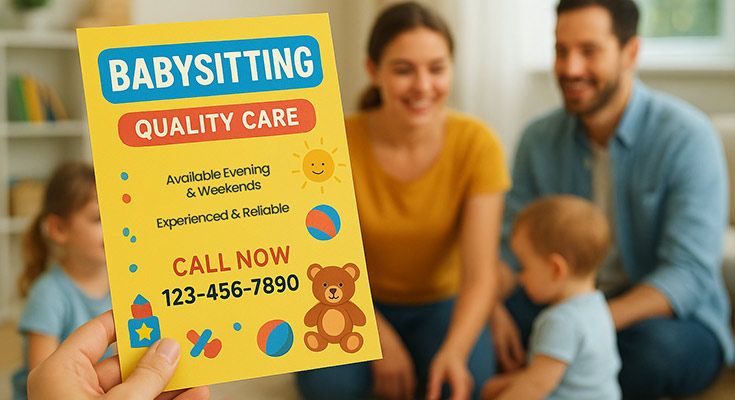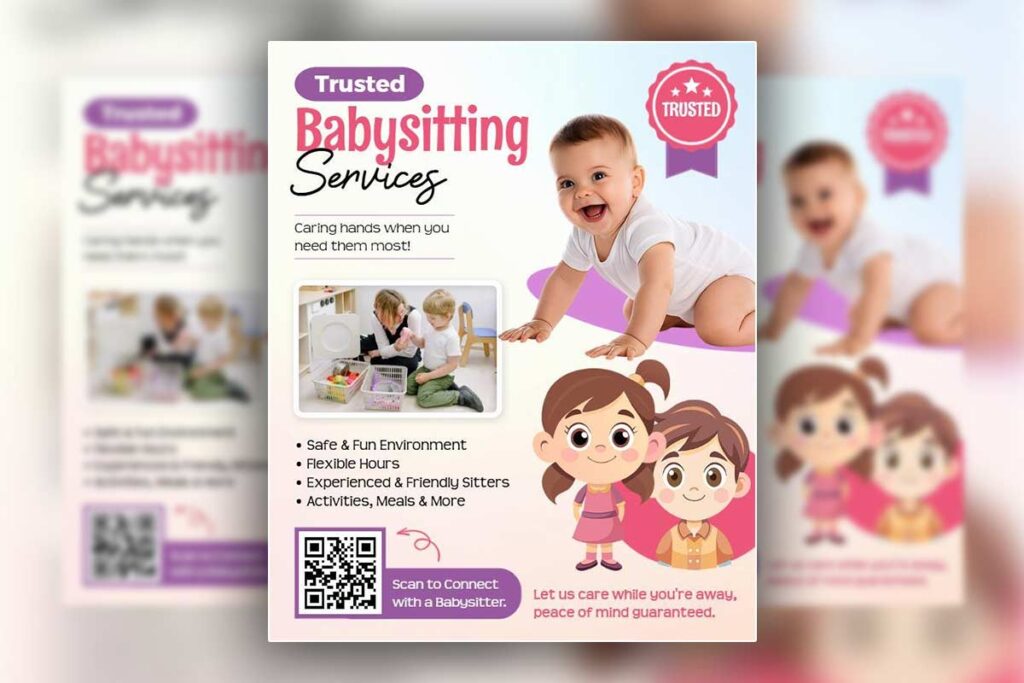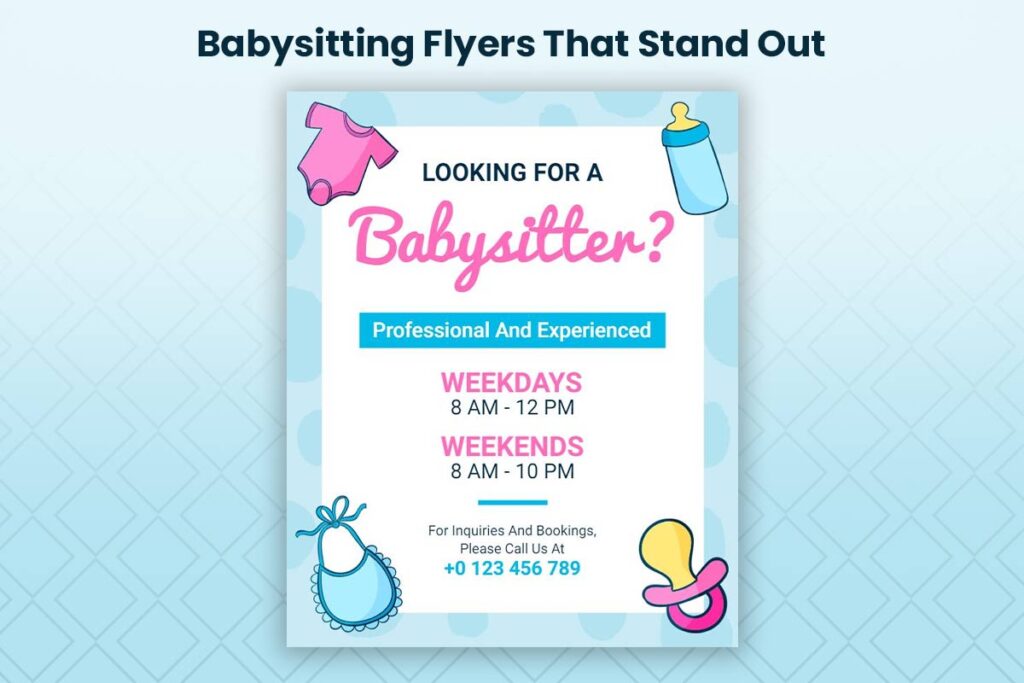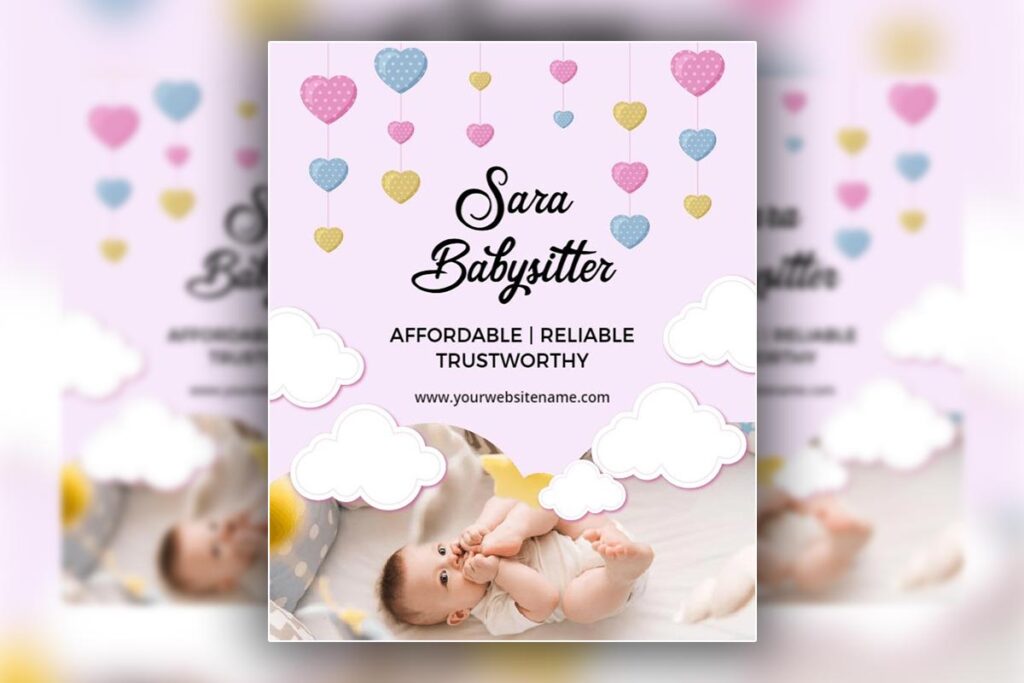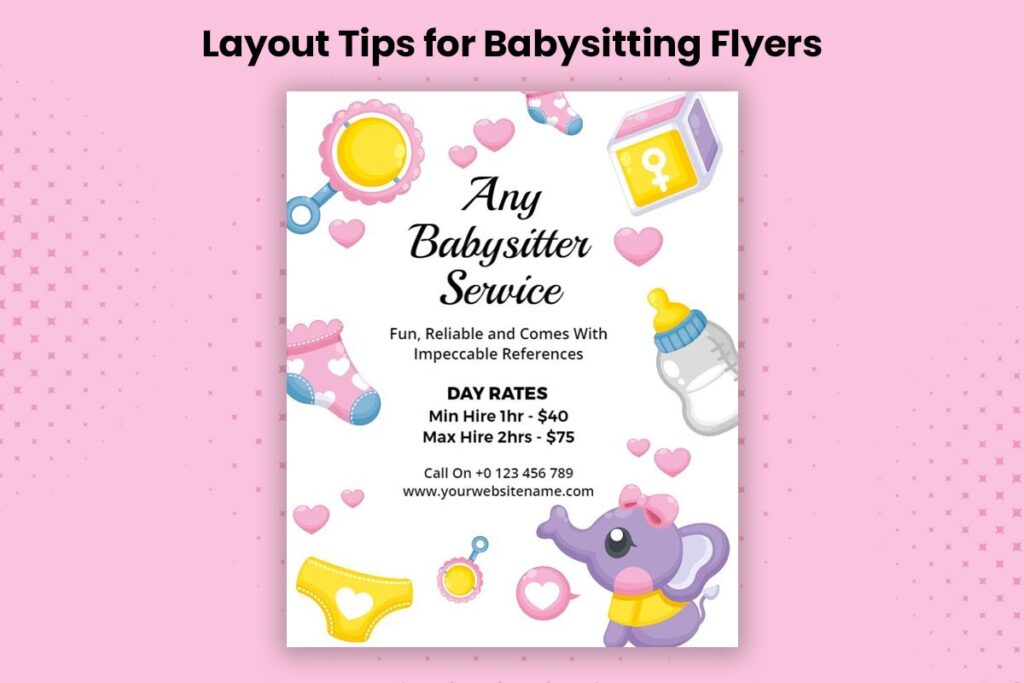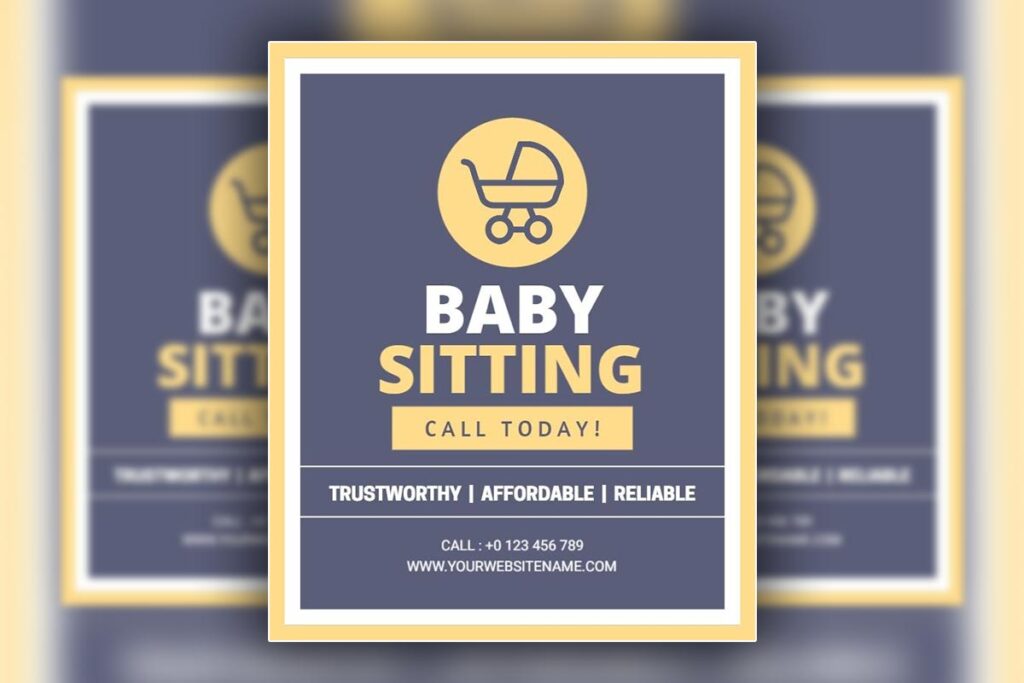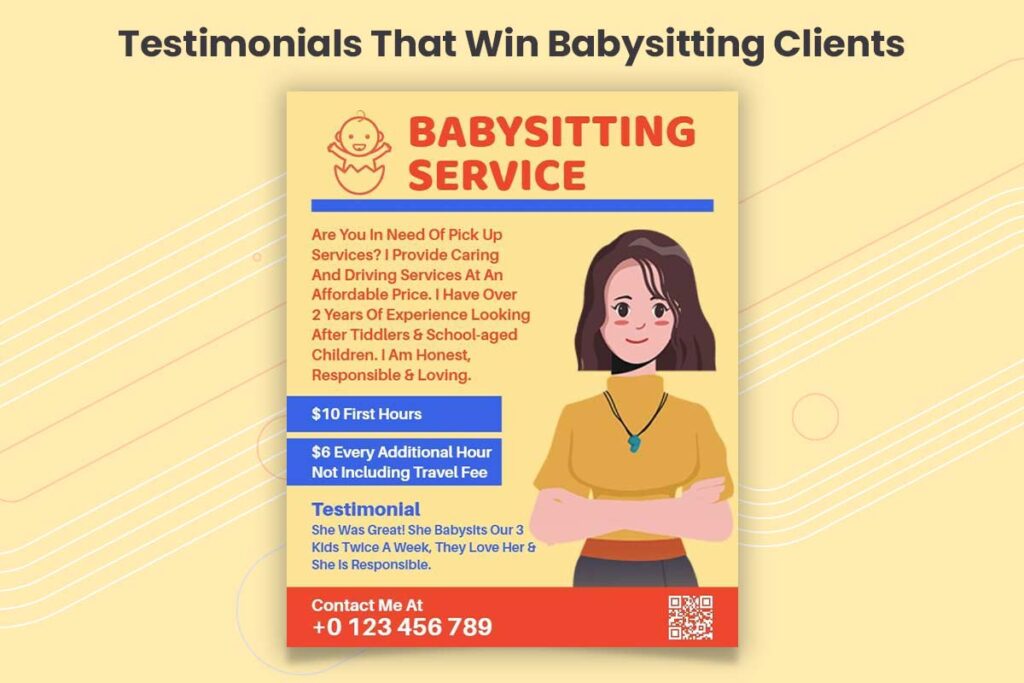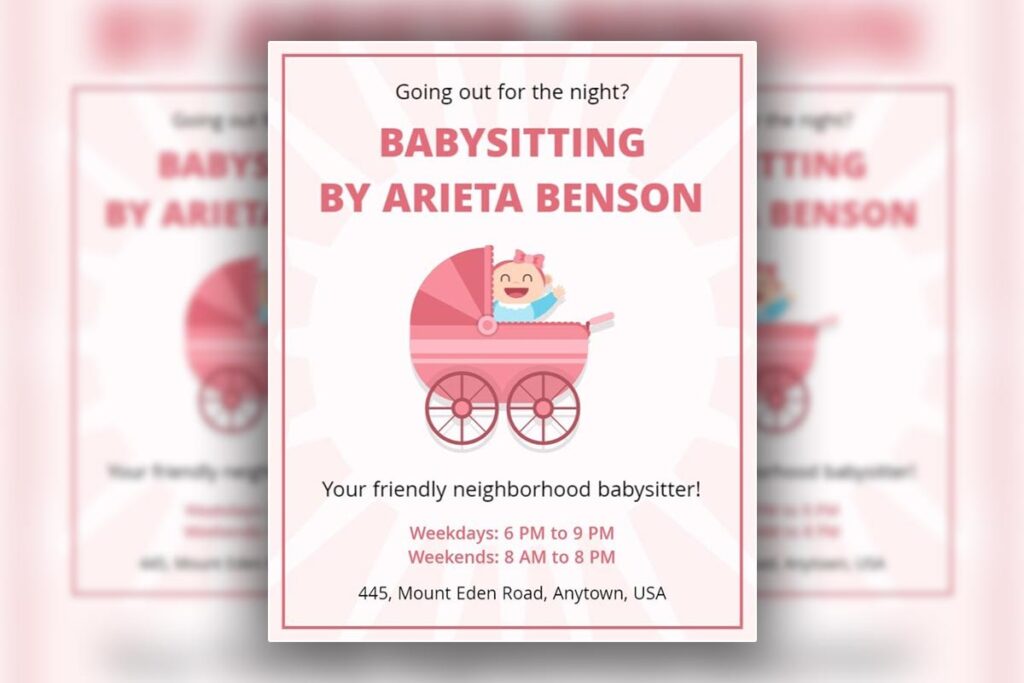A Babysitting service providers face intense competition and struggle to differentiate their services in markets with many similar providers offering comparable rates and credentials. Effective babysitting competitive flyers require strategic positioning that goes beyond basic qualifications to showcase unique value propositions that resonate with specific parent demographics. Successful competitive positioning combines professional babysitting flyer maker tools with targeted messaging that addresses core parent concerns about safety, reliability, and specialized expertise.
Creating effective babysitting service flyers design requires understanding how to differentiate through credential showcase, specialized service offerings, and strategic visual hierarchy that builds immediate trust. Professional positioning involves highlighting certifications like CPR training, special needs experience, or educational backgrounds that competitors lack. The most successful babysitting advertisement flyers integrate social proof through parent testimonials, demonstrate availability during peak demand periods, and present pricing structures that emphasize value over cost comparison.
This comprehensive guide covers flyer templates, messaging strategies for specific target demographics, testimonial integration techniques, and distribution strategies that maximize visibility in saturated markets while establishing sustainable competitive advantages.
What Design Elements Make Babysitting Competitive Flyers More Effective Than Standard Advertisements?
Competitive babysitting flyers outperform standard advertisements through strategic visual hierarchy, trust-building credentials display, and targeted messaging. Effective professional babysitting flyers incorporate safety certifications prominently, use warm yet professional color schemes, and feature authentic testimonial quotes with parent photos. Unlike generic ads, competitive flyers employ clear pricing structures, emergency contact protocols, and skill-specific icons (CPR, first aid, special needs experience). Strategic white space, readable fonts, and mobile-optimized layouts ensure information accessibility. These babysitting service flyers design elements create immediate credibility while addressing parents’ core concerns about reliability, safety, and professional competence in childcare services.
Credential Prominence and Trust Signal Integration
Babysitting competitive flyers leverage credential positioning through hierarchical badge displays and certification showcases. Place CPR certificates, background check verifications, and first aid training prominently in the upper third of your design. Professional babysitting flyers utilize trust signal clusters – grouping credentials, insurance verification, and professional memberships in distinct visual sections.
Strategic placement involves positioning most impressive qualifications near contact information, creating natural decision-making flow. Include specific credential details like “American Red Cross CPR Certified 2024” rather than generic “certified” claims. Visual trust indicators include professional headshots, years of experience counters, and safety protocol icons.
Babysitting service flyers design incorporates verification elements like QR codes linking to credential verification or professional references. This approach differentiates from standard advertisements by providing immediate credibility assessment tools parents can verify independently, addressing core safety concerns upfront rather than requiring follow-up inquiries.
- Trustworthy Baby Sitting Service Flyer Template
- Licensed Babysitting Services Promotional Flyer Template
Strategic Color Psychology and Professional Aesthetic Balance
Effective babysitting advertisement flyers employ color psychology through warm-professional palette combinations. Use soft blues for trustworthiness, gentle greens for nurturing qualities, and warm grays for professionalism. Avoid overly bright colors suggesting immaturity or stark business colors appearing impersonal.
Professional babysitting flyers balance playful elements with serious competence indicators. Incorporate subtle patterns or textures suggesting child-friendliness while maintaining clean, organized layouts. Typography choices combine readable sans-serif fonts for information with friendly script accents as seen in creative babysitting flyer design that demonstrates this balance naturally for personal touches.
Strategic contrast directs attention to critical information – contact details, pricing, and availability. How to make babysitting flyers stand out involves creating visual distinction through strategic color application rather than competing through brightness. Successful designs use 3-4 coordinated colors maximum, preventing visual overwhelm while establishing brand consistency across marketing materials and reinforcing professional presentation standards parents expect from childcare providers.
- Colorful Babysitting Service Promotion Flyer Template
- Playful Blue Babysitting Service Childcare Flyer Template
Testimonial Placement and Social Proof Optimization
Testimonial placement in babysitting competitive flyers requires strategic positioning for maximum impact. Position parent quotes near service descriptions, creating contextual relevance between claims and validation. Use specific testimonials mentioning measurable outcomes: “Sarah helped my 3-year-old overcome bedtime struggles within two weeks” rather than generic praise.
Visual testimonial formatting includes parent photos with quoted text, star ratings, and child age specifications. Create testimonial sections using background color differentiation, bordered quote boxes, or subtle typography changes distinguishing social proof from service descriptions. Include multiple testimonial types – reliability, child engagement, emergency handling, and special needs experience – addressing diverse parent concerns.
Babysitting flyer ideas that get noticed incorporate social proof diversity through client count indicators (“Trusted by 50+ local families”), longevity statements (“Serving [neighborhood] since 2020”), and repeat client percentages. Position strongest testimonials near call-to-action elements, reinforcing decision-making confidence.
Creating effective babysitting service flyers involves testimonial authenticity through specific details, photo inclusion, and verifiable claims.
- Babysitting Agency Service Promotion Flyer Template
- Professional Babysitting Availability Details Flyer Template
How Do You Create Babysitting Competitive Flyers That Stand Out In Saturated Markets?
Creating standout babysitting competitive flyers in saturated markets requires niche specialization messaging, innovative format approaches, and unique value proposition highlighting. Successful babysitting advertisement flyers differentiate through specialized services like ADHD support, multilingual capabilities, or educational enrichment programs. Implementing unconventional layouts, interactive elements, or QR codes linking to video introductions sets professional babysitting flyers apart from competitors. Market differentiation involves geographic targeting, premium service positioning, or exclusive availability windows that directly address unmet parent needs while maintaining professional credibility.
Niche Specialization Messaging and Service Differentiation
Stand out by highlighting specific expertise competitors lack. Target specialized needs like special needs childcare, overnight services, or educational tutoring alongside babysitting. Use messaging that addresses specific parent pain points: “ADHD-experienced caregiver” or “Bilingual homework assistance included.” Position yourself as the specialist rather than generalist.
Create service packages competitors don’t offer. Combine babysitting with light housekeeping, meal prep, or pet care. “Specialized childcare providers can command premium rates, with families paying significantly more for high-quality, specialized care services.1” Highlight certifications like autism support training, medication administration, or infant CPR beyond standard requirements.
Use specific age expertise messaging: “Toddler behavior specialist” or “Teen communication expert.” Parents value providers who understand their child’s developmental stage. Include years of experience with specific age groups and successful behavior management examples that demonstrate your specialized knowledge.
- Babysitter Service Availability Flyer Template
- Babysitting Service Contact Information Flyer Template
Innovative Format Design and Interactive Technology Integration
Break away from standard rectangular flyers with creative shapes matching your service theme. Use door hangers, magnets, or fold-out designs that parents keep rather than discard. Interactive elements like QR codes linking to introduction videos or online scheduling systems modernize your approach.
Incorporate technology strategically. Create QR codes linking to parent testimonial videos, safety credential verification, or instant availability calendars.
Digital marketing campaigns targeting parents show significant engagement rates and cost-effectiveness when promoting childcare-related services. The study found that digital integration in marketing materials can substantially increase inquiry rates compared to traditional approaches.2
Design visual portfolios within your flyer. Include photos of activities you’ll do with children, sample homework help materials, or emergency protocol checklists. Use infographics showing your qualifications versus typical providers. Create scannable content with icons, charts, and visual hierarchy that busy parents process quickly.
Geographic Targeting and Premium Positioning Strategies
Research neighborhood-specific needs and customize messaging accordingly. Affluent areas value educational enrichment and safety credentials, while working-class neighborhoods prioritize reliability and affordability. Adjust your professional babysitting flyers language, service emphasis, and pricing presentation to match local expectations.
Position premium services through exclusive availability messaging. Use phrases like “Limited client roster” or “Selective scheduling” to create desirability. Highlight waitlists or referral-only availability that suggests high demand. Premium positioning works when backed by exceptional qualifications and social proof.
Create location-specific value propositions. Mention familiarity with local schools, pediatric offices, or family-friendly venues. Include neighborhood references like “Serving Maple Heights families since 2020” that build local credibility. Use geographic keywords in your babysitting flyer marketing strategies that help parents find locally-focused providers.
Develop territory exclusivity by specializing in specific subdivisions or school districts. Become the known provider for particular areas through consistent presence and word-of-mouth building. This geographic focus reduces competition while building concentrated market recognition for your childcare service flyers.
What Messaging Strategies Work Best For Babysitting Competitive Flyers Targeting New Parents?
Effective babysitting competitive flyers targeting new parents emphasize safety credentials, infant expertise, and empathy for exhausted parents’ specific challenges. Messages that combine concrete qualifications with understanding of new parent anxieties create trust while addressing core concerns about leaving babies with unfamiliar caregivers. Professional babysitting flyers succeed by highlighting CPR certification, background checks, and references from families with infants, while new babysitter lead generation flyers help new providers attract their first clients. Emotional messaging acknowledging the difficulty of trusting someone new with precious babies, paired with specific qualifications, produces the most compelling babysitting service flyers design for this demographic.
Safety-First Messaging That Addresses New Parent Concerns
New parents prioritize safety above all other considerations when selecting childcare. Babysitting competitive flyers should lead with certifications prominently displayed: “CPR & First Aid Certified,” “Background Checked & Bonded,” and “Infant Care Training Completed.” Include specific credentials like “Pediatric First Aid through American Red Cross” rather than vague safety claims. Address common fears directly with messages like “Your baby’s safety is my priority” followed by specific protocols. Mention emergency preparedness with phrases such as “Emergency contact system ensures parents reach me instantly” and “Documented allergy and medical information protocols.” Trust indicators like “Licensed & Insured” and “References from 20+ families with newborns” provide concrete reassurance that resonates with safety-conscious new parents.
- Child Safety Babysitting Course Flyer Template
- Trusted Babysitting Services Advertisement Flyer Template
Experience-Based Communication for Infant and Toddler Care
New parents need confidence that caregivers understand infant-specific needs beyond basic babysitting. Highlight specialized training with messages like “Experienced with newborns 0-12 months” and “Certified in infant sleep training techniques.” Include specific capabilities: “Bottle feeding, diaper changing, and soothing techniques for fussy babies.” Address developmental understanding with phrases such as “Age-appropriate activities for your baby’s growth stage” and “Tummy time and developmental milestone support.” How to make babysitting flyers stand out by featuring unique infant expertise like “Experience with premature babies” or “Familiar with breastfeeding support for nursing mothers.” Quantify experience meaningfully: “3+ years specializing in infant care” carries more weight than generic childcare experience claims.
- Babysitter Qualification Checklist Flyer Template
- Professional Babysitter Service Promotion Flyer Template
Flexibility and Reliability Messages for Sleep-Deprived Parents
Sleep-deprived parents value reliability and accommodation above convenience. Address unpredictable schedules with “Available for last-minute requests” and “Flexible evening and weekend hours.” Acknowledge parental exhaustion with empathetic language: “I understand how overwhelming new parenthood feels” and “Reliable care so you can rest or run errands.” Offer specific support: “Light housekeeping while baby sleeps,” “Meal preparation assistance,” and “Grocery runs during nap time.” Professional babysitting flyers should emphasize communication with “Hourly text updates with photos” and “Detailed care logs for feeding and sleeping.” Address guilt with supportive messaging: “Taking breaks makes you a better parent” and “Your self-care benefits your baby.” Include practical convenience like “Familiar with baby gear setup” and “Comfortable with multiple children if siblings arrive.” Creating effective babysitting service flyers means balancing professionalism with warmth, showing both competence and genuine care for family wellbeing during this vulnerable time.
How Can Babysitting Competitive Flyers Highlight Unique Qualifications Over Competitors?
Professional babysitting flyers differentiate through specific credential showcasing, specialized training highlights, and unique service offerings that competitors lack. Effective babysitting advertisement flyers emphasize certifications like pediatric first aid, early childhood education degrees, or special needs experience. Visual hierarchy in babysitting flyer templates should prominently feature exclusive qualifications such as language skills, educational activities, or overnight care availability. Quantifiable achievements like years of experience, number of families served, or specific age group expertise create measurable differentiation that helps parents compare providers objectively.
Credential Positioning That Outshines Standard Qualifications
Position advanced certifications prominently using visual hierarchy that draws attention to unique qualifications. CPR certification becomes “Pediatric CPR + First Aid Certified,” while basic background checks become “FBI Background Check + Child Abuse Registry Cleared.” Quantify experience with specific metrics: “5+ years with infants under 6 months” rather than generic experience claims. Include professional development credentials like “Montessori Training Certified” or “Special Needs Care Specialist” that demonstrate investment in skill advancement. Educational background positioning matters highlight relevant degrees like Early Childhood Development or Child Psychology prominently. Create credential hierarchies using font sizes and visual elements that make premium qualifications immediately visible, establishing expertise that justifies higher rates.
Specialized Training Showcase for Niche Expertise Areas
Highlight specialized skills that address specific parent concerns through dedicated sections on your babysitting competitive flyers. Showcase multilingual capabilities with flags or language icons, especially for diverse communities seeking cultural connectivity. Position special needs experience prominently if applicable autism spectrum support, ADHD management, or developmental delay experience commands premium rates. Educational enrichment skills like homework assistance, reading programs, or music instruction differentiate from basic supervision providers. Emergency response training beyond standard CPR severe allergy management, asthma care protocols, or diabetic emergency procedures builds parent confidence. Age-specific expertise matters: newborn care specialists, toddler behavior management, or teenage mentoring capabilities. Present specialized training with completion dates and issuing organizations to build credibility.
- Babysitting Skills Development Workshop Flyer Template
- Experienced Babysitting Service Advertisement Flyer Template
Service Portfolio Differentiation Through Unique Offerings
Expand service descriptions beyond basic childcare to include value-added offerings that justify premium positioning. Light housekeeping, meal preparation, or homework assistance create comprehensive care packages that busy parents value. Transportation services for after-school activities or appointments appeal to working families needing logistical support. Overnight care availability for parents needing date nights or emergency coverage commands higher rates than daytime-only providers. Educational activities like art projects, nature exploration, or STEM activities position you as developmental partner rather than mere supervisor. Flexible scheduling accommodations last-minute availability, holiday coverage, or extended hours address common parent pain points. Pet care integration appeals to families wanting comprehensive home management. Create service tiers showing basic, premium, and comprehensive packages that allow parents to choose coverage levels. Emergency response protocols and parent communication systems regular updates, photo sharing, or incident reporting build trust through transparency and professional communication standards.
What Layout Techniques Make Babysitting Competitive Flyers More Visually Appealing?
Effective babysitting competitive flyers leverage strategic visual hierarchy through contrasting font sizes, with service titles in bold headers and contact details prominently displayed. “The larger the element, the more attention it will attract, compared to smaller elements.3” Color psychology plays a crucial role warm, trustworthy blues and soft greens convey reliability, while avoiding overly bright colors that suggest immaturity. White space management prevents cluttered appearance, allowing key information to breathe. Professional photography or illustrations of happy children (with proper permissions) create emotional connection. Grid-based layouts ensure balanced information distribution, while directional elements like arrows guide readers toward call-to-action sections. These layout fundamentals help babysitting service flyers stand out in competitive markets.
Color Psychology and Trust-Building Elements in Babysitting Advertisement Flyers
Professional babysitting flyers use color psychology to build immediate parent trust. Navy blue conveys dependability and professionalism, while soft greens suggest nurturing care. Avoid bright reds or oranges that may signal chaos or hyperactivity. Background colors should remain neutral cream, light gray, or white to maintain readability and professional appearance.
Trust-building visual elements include certification badges positioned prominently in the top third of babysitting service flyers design. Background checks, CPR certification, and first aid training should feature consistent color coding. Use accent colors sparingly for important details like phone numbers or emergency contact information. Color consistency throughout the flyer reinforces brand professionalism.
Consider your target demographic when selecting color palettes. Affluent families respond well to sophisticated color combinations, while working families prefer practical, straightforward color schemes that communicate reliability and affordability.
- Trusted Babysitting Services Promotional Flyer Template
- Community Center Babysitting Nights Flyer Template
Strategic Photography Placement and Visual Flow Optimization
Visual flow in babysitting competitive flyers follows the Z-pattern reading sequence, placing key information at strategic intersection points. Position your professional headshot in the top-left corner, establishing immediate personal connection. Service highlights occupy the top-right section, while testimonials anchor the bottom-left quadrant.
Photography placement requires careful consideration of image rights and professional boundaries. Use stock images of children or obtain proper permissions from families. Images should support, not overwhelm, text content maintain 60% text to 40% visual ratio for optimal information density.
Create visual pathways using directional photography. Children looking toward important text sections naturally guide reader attention. Avoid competing visual elements that fragment attention. Each image should serve a specific purpose: building trust, demonstrating service quality, or showcasing professional qualifications.
Professional babysitting flyers benefit from consistent image styling similar filters, lighting, and composition create cohesive brand presentation that differentiates your childcare service flyers from amateur competitors.
Typography Hierarchy Systems for Professional Babysitting Flyers
Typography hierarchy in babysitting flyer templates establishes clear information priority through systematic font size variations. Primary headlines use 24-36pt fonts for service names, while subheadings range from 16-20pt for qualification categories. Body text maintains 11-12pt size for optimal readability without overwhelming busy parents scanning multiple flyers.
Font selection impacts professional perception significantly. Sans-serif fonts like Helvetica or Arial project modern reliability, while carefully chosen serif fonts can add trustworthy tradition. Avoid script fonts for primary text, they reduce readability and may appear unprofessional to discerning parents.
Establish visual hierarchy through strategic font weights and styles. Bold formatting emphasizes certifications, qualifications, and contact information. Italic styling works effectively for testimonial quotes but should remain limited to prevent visual confusion. Color variations can reinforce typography hierarchy, using darker shades for important information and lighter tones for supplementary details.
Consistent spacing between typography elements prevents cramped appearance while maintaining information density. Line spacing should be 1.2-1.5x font size for comfortable reading. Paragraph breaks every 3-4 lines improve scannability for time-pressed parents evaluating babysitting flyer marketing strategies.
How Do You Price And Position Services Effectively On Babysitting Competitive Flyers?
Successful babysitting competitive flyers position pricing through value-based messaging rather than competing solely on cost. Service bundling presentations showcase package deals like “evening care plus light housekeeping” to justify premium rates. Transparent pricing structures with clear hourly ranges ($15-25/hour) build trust while allowing flexibility. Competitive positioning emphasizes unique qualifications – CPR certification, early childhood education, or specialized experience with special needs children. Effective babysitting competitive flyers focus on service differentiation rather than price competition. Social proof integration through parent testimonials reinforces value proposition. Geographic targeting helps position services within local market contexts, acknowledging that suburban rates differ from urban pricing expectations in professional babysitting flyers.
- Affordable Babysitting and Childcare Service Flyer Template
- Affordable Babysitting Services Promotion Flyer Template
Value-Based Messaging Strategies Beyond Hourly Rate Comparisons
Professional babysitting flyers succeed by emphasizing service value over price competition. Highlight specialized skills like homework assistance, meal preparation, or bedtime routine expertise that justify higher rates. Position certifications prominently – CPR, First Aid, and early childhood education create perceived value worth premium pricing. Create service tiers showcasing basic care versus enrichment activities. Babysitting competitive flyers that emphasize qualifications achieve 30% higher response rates than price-focused alternatives. Include testimonials focusing on outcomes: “Sarah helped my son with math homework every session.” Demonstrate reliability through availability windows and emergency flexibility. Position experience quantifiably “5 years with special needs children” or “fluent in Spanish for bilingual families.” Create urgency through limited availability messaging rather than discount offers.
Service Package Presentation and Premium Positioning Techniques
Effective babysitting service flyers design packages that increase perceived value while differentiating from competitors. Bundle complementary services: “Evening Care Package includes dinner prep, homework help, and bedtime stories.” Present three pricing tiers allowing parents to choose comfort levels while anchoring higher-value options. Premium positioning emphasizes exclusive availability “accepting only 3 new families this month” creates desirability. Include add-on services separately: pet care, light housekeeping, or tutoring support. Display package savings: “Save $5/hour with our 4-hour evening package.” Position specialized expertise as premium offerings overnight care, newborn experience, or special dietary management. Use professional language avoiding casual terms that suggest amateur service. Create scarcity through geographic limitations: “serving Westside neighborhoods only.”
Local Market Context and Geographic Pricing Adaptation Methods
Successful babysitting advertisement flyers adapt pricing presentation to local market expectations and demographic characteristics. Research neighborhood income levels through census data and adjust pricing displays accordingly. Affluent areas support detailed premium service descriptions while value-conscious markets emphasize reliability and basic qualifications. Urban markets expect higher rates ($20-30/hour) while suburban areas typically range $15-22/hour. Include transportation considerations for service area boundaries, “serving downtown core with 15-minute response time.” Position against local competitors by highlighting unique geographic advantages: “only certified provider in Riverside district.” Acknowledge market realities: “competitive rates for our area” suggests awareness without underselling. Reference local landmarks or school districts to demonstrate neighborhood familiarity. Adjust service emphasis based on community needs working family areas emphasize after-school care while affluent neighborhoods highlight enrichment activities. Include parking availability or public transit access relevant to local geography.
What Call-to-action Elements Drive The Most Responses On Babysitting Competitive Flyers?
High-converting babysitting competitive flyers leverage urgency-driven CTAs like “Book Your First Session Today” and safety-focused prompts such as “Get Your Free Background Check Review.” Multi-channel contact options including phone, text, and online booking maximize response rates by meeting different parent communication preferences. Limited-availability messaging creates immediate action, while trust-building elements like “Licensed & Insured” within CTAs address core safety concerns. Professional babysitting flyers that combine specific action verbs with clear benefits consistently outperform generic “Call Now” messages, especially when positioned prominently with contrasting colors and readable fonts throughout babysitting service flyers design.
- Caring Babysitting Service Advertisement Flyer Template
- Reliable Babysitting Services Advertisement A4 Flyer Template
Urgency-Based CTA Phrases That Generate Immediate Parent Inquiries
Effective babysitting advertisement flyers create immediate response through scarcity-based messaging like “Only 3 Evening Slots Available This Month” or “Book Now – Weekend Spots Filling Fast.” Time-sensitive offers such as “Free Meet & Greet This Week Only” capitalize on parents’ decision-making urgency when childcare needs arise unexpectedly.
Seasonal urgency works particularly well with phrases like “Summer Care Registration Ends Friday” or “Back-to-School Babysitters – Reserve Yours Now.” Action-oriented language such as “Secure Your Trusted Sitter Today” combines urgency with reliability messaging. The most effective babysitting flyer templates position urgency CTAs prominently near contact information, using bold fonts and contrasting colors to ensure visibility. Parents respond faster to specific timeframes rather than vague urgency, making “Call Within 24 Hours for This Week’s Availability” more effective than generic “Limited Time Offer” messaging in competitive markets.
Multi-Platform Contact Integration Strategies for Maximum Response Rates
Best babysitting flyer designs for competition include multiple contact methods to accommodate different parent communication styles. Phone numbers remain essential for immediate needs, while text messaging appeals to busy parents preferring quick coordination. Professional email addresses establish credibility for detailed inquiries and scheduling coordination.
QR codes linking to online booking systems or detailed profiles capture tech-savvy parents who prefer digital interactions. Social media handles on platforms like Care.com or local parent Facebook groups provide additional verification channels. Response time commitments like “Text Response Within 2 Hours” or “Email Reply Same Day” set clear expectations and demonstrate reliability.
Effective childcare service flyers organize contact information hierarchically, with primary methods (phone/text) prominently displayed and secondary options (email/social) clearly visible but not competing for attention. Including preferred contact times like “Text Anytime – Call Before 8 PM” helps parents choose appropriate communication methods.
Trust-Building CTA Language That Addresses Parent Safety Concerns
Parents prioritize safety verification over convenience, making trust-building CTAs essential for babysitting promotional materials success. Phrases like “Schedule Your Background-Checked Sitter” or “Book Your CPR-Certified Caregiver” directly address core safety concerns while prompting action. Reference verification language such as “Call My 5+ Parent References” provides immediate credibility and encourages contact.
Certification-focused CTAs like “Meet Your First Aid Trained Sitter” or “Book Your Licensed Childcare Provider” combine qualifications with action verbs. Insurance messaging within CTAs such as “Hire Your Bonded & Insured Babysitter” addresses liability concerns while encouraging commitment.
Trial period offers reduce perceived risk with CTAs like “Schedule Your Risk-Free Trial Session” or “Book Your No-
How Can Babysitting Competitive Flyers Showcase Testimonials And Social Proof Effectively?
Successful babysitting competitive flyers leverage authentic testimonials through strategic visual design that positions social proof at key decision points. Professional babysitting flyers place parent testimonials prominently near contact information while integrating multiple credibility indicators like certifications, experience metrics, and client ratings. Creating effective babysitting service flyers requires balancing genuine parent quotes with visual trust symbols that instantly communicate reliability and expertise. The most effective babysitting flyer templates combine specific testimonial details like “Sarah helped our anxious 4-year-old feel comfortable immediately” with quantifiable social proof such as “50+ families served” or “5-star average rating.”
Strategic Placement Techniques for Maximum Testimonial Impact on Flyers
Best babysitting flyer designs for competition position testimonials in three strategic zones for optimal conversion. The header section features brief, powerful quotes that immediately establish credibility upon first glance. How to make babysitting flyers stand out involves placing longer testimonials with specific details near service descriptions, allowing parents to connect qualifications with real experiences. The most impactful placement occurs adjacent to contact information, where testimonials reinforce the decision to reach out. “Professional babysitting flyers use visual hierarchy to make testimonials scannable through quote boxes, different font styles, and strategic white space.4” Effective placement includes parent names and child ages for authenticity while maintaining privacy. Babysitting service flyers design should avoid cluttering testimonials together, instead distributing them throughout the layout to maintain visual flow while consistently reinforcing credibility.
Visual Social Proof Elements That Build Instant Parent Trust
Visual credibility elements create immediate trust before parents read detailed testimonials. Creating effective babysitting service flyers incorporates certification badges, star ratings, and experience metrics prominently in the design hierarchy. Professional photos of happy children with permission build emotional connection while safety certification logos like CPR and First Aid create instant credibility. Babysitting flyer marketing strategies include client count displays (“Trusted by 100+ Local Families”), years of experience indicators, and background check verification symbols. “Color-coded trust indicators help busy parents quickly assess qualifications at a glance.5” Visual testimonials with authentic family photos outperform text-only reviews by creating personal connections. Effective babysitting advertisement flyers use consistent branding for trust elements while ensuring readability and professional appearance across all visual proof components.
Combining Multiple Proof Types to Overcome Competitive Market Skepticism
Comprehensive social proof strategy combines testimonials, certifications, and performance metrics to address all parent concerns. Babysitting competitive flyers succeed by layering different proof types that reinforce each other rather than competing for attention. Quantifiable metrics like “Average 4.9/5 parent rating” paired with specific testimonials like “Emma’s patience with our toddler’s bedtime routine was incredible” create compelling credibility combinations. Professional babysitting flyers address different parent priorities through varied proof types: safety concerns through certifications, reliability through testimonials, and experience through metrics and can be made even more effective using engaging babysitting flyers for competitive market to stand out in a crowded market. Babysitting promotional materials that integrate emergency contact protocols with parent testimonials about crisis handling build comprehensive trust. The most effective approach includes recent testimonials that mention current challenges like remote learning support or pandemic safety measures. Childcare service flyers should balance social proof density with visual clarity, ensuring multiple trust indicators enhance rather than overwhelm the design while creating clear pathways to conversion.
What Distribution Strategies Maximize Visibility For Babysitting Competitive Flyers?
Effective distribution of babysitting competitive flyers requires strategic placement in high-traffic family areas and digital amplification. Position professional babysitting flyers at pediatric offices, community centers, schools, and grocery stores where parents frequently visit. Combine physical distribution with digital channels by posting babysitting service flyers design on neighborhood apps, social media groups, and parenting forums. Partner with complementary businesses like tutoring centers or children’s activity providers for cross-promotion. Track distribution effectiveness through unique contact methods on each flyer placement to optimize your babysitting advertisement flyers strategy and maximize return on investment.
Strategic Physical Placement Locations for Maximum Parent Exposure
Maximize babysitting competitive flyers exposure through systematic placement at parent-dense locations. Pediatrician offices offer direct access to families with young children, while waiting areas provide extended viewing time. Target school pickup zones, preschool bulletin boards, and after-school program centers where parents actively seek childcare solutions. Grocery stores with family-friendly reputations and community centers hosting children’s activities deliver consistent parent traffic.
Effective placement timing matters significantly. Position flyers during peak parent hours school pickup times, weekend family activities, and evening grocery runs. Secure permission from location managers and follow posted guidelines. Create location-specific variations highlighting relevant services like after-school care for school placements or weekend availability for community centers. Track response rates through unique phone numbers or email addresses for each location to identify highest-performing placement strategies for future babysitting flyer marketing strategies optimization.
Digital Distribution Channels That Amplify Flyer Reach
Digital distribution multiplies physical flyer visibility through targeted online communities. Neighborhood apps like Nextdoor and Ring Neighbors provide direct access to local families actively seeking babysitting services. Facebook parenting groups and community pages offer engaged audiences discussing childcare needs regularly.
Post professional babysitting flyers in local Facebook groups, community forums, and school parent pages. Instagram Stories and posts showcase flyer designs while building personal connections with families. Create QR codes linking physical flyers to digital portfolios or booking systems or use a babysitting flyer platform for digital savvy babysitters to manage and distribute your flyers efficiently. Email digital versions to existing clients for referral sharing.
Optimize timing for maximum visibility post during evening hours when parents browse social media after work. Share in multiple relevant groups to expand reach while respecting community guidelines. Track digital engagement through link clicks, saves, and shares to measure creating effective babysitting service flyers performance across platforms and refine distribution strategies.
Partnership Networks and Cross-Promotional Distribution Opportunities
Strategic partnerships exponentially increase babysitting competitive flyers visibility through complementary business relationships. Children’s activity providers dance studios, martial arts centers, tutoring services serve identical target demographics with non-competing services. These partnerships create mutually beneficial flyer exchanges reaching qualified parent audiences.
Develop formal cross-promotion agreements with businesses serving families. Offer reciprocal flyer placement in exchange for displaying partner materials. Target businesses where parents spend time waiting music lessons, sports practices, orthodontist offices. Create partner-specific flyer variations highlighting services relevant to each business’s clientele.
Establish relationships with real estate agents, moving companies, and relocation services targeting families new to areas who need immediate babysitting services. Partner with children’s birthday party venues and event planners for temporary childcare opportunities. Connect with local family photographers who interact with parents planning events.
Track partnership effectiveness through dedicated contact information for each relationship. Monitor which partnerships generate highest-quality leads versus simple volume. Strengthen successful partnerships through regular communication and exclusive offers for partner referrals. This systematic approach transforms babysitting promotional materials distribution from scattered placement into targeted, measurable campaigns generating consistent client inquiries through proven channels.
How Do You Adapt Babysitting Competitive Flyers For Different Target Demographics?
Adapting babysitting competitive flyers for different demographics requires understanding unique parent needs and communication preferences. Working families prioritize reliability and scheduling flexibility, requiring babysitting flyer templates that emphasize availability and credentials. Affluent families focus on educational enrichment and safety certifications in professional babysitting flyers. Single parents value affordability and emergency availability messaging. Age-specific targeting matters too, parents of toddlers need different reassurances than those with teenagers. Customize babysitting service flyers design elements, language tone, service highlights, and pricing presentation to resonate with each demographic’s specific childcare priorities and decision-making factors.
Working Family vs. Stay-at-Home Parent Flyer Customizations
Working families need babysitting advertisement flyers emphasizing after-hours availability, pickup services, and homework assistance. Highlight flexible scheduling, weekend availability, and emergency backup care. Use professional imagery showing organized activities and structured routines. Include transportation credentials and meal preparation capabilities.
Stay-at-home parents prefer babysitting flyer ideas that get noticed through playdate coordination, educational activities, and social development support. Emphasize creative play, outdoor activities, and child enrichment programs. Feature testimonials about engaging activities and positive child development outcomes rather than convenience factors.
Income-Based Service Positioning and Pricing Presentation
High-income families respond to premium positioning in creating effective babysitting service flyers. Emphasize advanced certifications, specialized training, and exclusive services. Present pricing as value packages rather than hourly rates. Include concierge-style services, educational enrichment, and personalized care plans.
Budget-conscious families need transparent pricing and value emphasis in babysitting flyer marketing strategies. Highlight affordability, flexible payment options, and basic reliable services. Use straightforward language about rates and include package deals or sibling discounts. Focus on safety and dependability over premium amenities.
Child Age-Specific Messaging and Service Emphasis Strategies
Infant care requires specialized messaging in best babysitting flyer designs for competition. Highlight newborn experience, feeding expertise, sleep training knowledge, and pediatric first aid certification. Use calming colors and include specific infant safety protocols. Parents of babies prioritize experience with newborns and emergency preparedness.
Toddler-focused babysitting flyer templates emphasize patience, creativity, and behavioral management skills. Highlight experience with potty training, tantrums, and developmental activities. Include testimonials about positive behavioral outcomes and engaging toddler activities.
School-age children require how to make babysitting flyers stand out through homework help, transportation services, and after-school activities. Emphasize academic support, sports pickup, and structured routine maintenance. Include credentials in tutoring or educational support.
Teenagers need professional babysitting flyers highlighting respect, independence balance, and emergency preparedness. Focus on trust-building, appropriate supervision levels, and communication skills with older children. Emphasize driving credentials and technology boundaries management.
Each demographic adaptation ensures your babysitting promotional materials speak directly to specific parent concerns while maintaining professional credibility and clear service differentiation.
People Also Ask: Flyer Competitive Positioning And Brand Differentiation
- How to make a babysitting flyer stand out from competitors?
Use professional photography, unique color schemes, and specific qualifications that differentiate your services. Include measurable credentials, testimonials with results, and clear value propositions that address parent concerns better than generic providers. - What should I put on a competitive babysitting flyer?
Include professional photo, specific certifications, experience details, service area, availability, pricing ranges, parent testimonials, emergency training credentials, and unique services like homework help or special needs experience that competitors lack. - How to price babysitting services competitively on flyers?
Research local market rates and position pricing with value justifications. Include starting rates with service tiers, highlight premium qualifications, and offer package deals or loyalty discounts to compete effectively against lower-priced providers. - What makes babysitting flyers more professional looking?
Use consistent branding, high-quality images, clean typography, and organized layout. Include professional credentials, structured service descriptions, and polished contact information. Avoid cluttered designs or amateur graphics that diminish credibility with discerning parents. - How to distribute babysitting competitive flyers effectively?
Target family-oriented locations like pediatric offices, playgrounds, schools, and community centers. Use digital versions for social media and parent groups. Focus on high-traffic areas where your target demographic naturally gathers. - What design elements make babysitting flyers more eye-catching?
Use bold headlines, contrasting colors, strategic white space, and professional imagery. Include icons for services, clear section divisions, and standout testimonial boxes. Balance visual appeal with readable, scannable information layout for busy parents.
FAQs: Flyer Competitive Positioning And Brand Differentiation
- How do I differentiate my babysitting flyer from dozens of similar providers in my area?
Focus on unique value propositions like specialized training, flexible scheduling, or specific age expertise. Use distinctive visual branding, professional photos, and highlight exclusive services competitors don’t offer. Include specific credentials, certifications, or experience that sets you apart from generic babysitting providers in your market. - What makes babysitting competitive flyers more effective than basic advertising materials?
Competitive flyers strategically address parent concerns, showcase measurable qualifications, and present clear value differentiators. They include social proof, professional design elements, and targeted messaging that speaks directly to your ideal client’s needs rather than using generic babysitting language. - Should I include pricing on my babysitting competitive flyers to stay competitive?
Include pricing ranges or starting rates to filter qualified inquiries and demonstrate transparency. Position pricing alongside value propositions like experience level, certifications, or special services. This prevents price-shopping while attracting parents who value quality childcare over cheapest options. - How do I create urgency on babysitting flyers without seeming pushy?
Use scarcity messaging like ‘limited evening availability’ or seasonal positioning such as ‘summer care spots filling fast.’ Offer early booking discounts or mention high demand periods. Frame urgency around your schedule limitations rather than aggressive sales tactics. - What testimonial format works best for competitive babysitting flyers?
Use specific, results-focused testimonials that mention your unique strengths. Include parent’s first name, child’s age, and specific benefits like ‘Sarah helped my 3-year-old overcome bedtime struggles.’ Brief, credible testimonials with measurable outcomes outperform generic praise statements. - How can I make my babysitting flyer memorable in busy neighborhoods?
Use distinctive visual elements like unique color schemes, memorable taglines, or creative layouts. Include a professional headshot, specific service area coverage, and standout qualifications. Consider unique paper quality or formats that feel premium compared to standard flyer materials. - What’s the optimal length for competitive babysitting flyer content?
Keep core information scannable within 10-15 seconds while providing enough detail to demonstrate professionalism. Use bullet points for qualifications, clear headers for services, and concise but compelling descriptions. Balance comprehensive information with readable, uncluttered design that busy parents can quickly process. - How do I target working families specifically with my babysitting flyer design?
Emphasize flexibility, reliability, and after-school or evening availability. Highlight experience with homework help, meal preparation, or transportation services. Use professional imagery and language that resonates with career-focused parents who need dependable, structured childcare solutions. - What contact information strategy works best for competitive babysitting flyers?
Provide multiple contact options including phone, email, and professional social media profiles. Consider QR codes linking to detailed portfolios or booking systems. Make your response timeframe clear and professional, showing busy parents you understand their scheduling needs. - How often should I update my babysitting competitive flyers to stay current?
Refresh flyers every 3-6 months or when adding new certifications, services, or availability. Update seasonal messaging, current testimonials, and pricing adjustments. Regular updates prevent your materials from looking outdated compared to newer providers entering your market.
CONCLUSION: Flyer Competitive Positioning And Brand Differentiation Success Framework
Creating babysitting flyers that stand out in saturated markets requires more than generic promotion, it demands strategic differentiation. Effective flyers establish credibility through professional design, clear visual hierarchy, and trust-building elements such as safety certifications, specialized training, and compelling testimonials. By combining warm, approachable aesthetics with quality-focused messaging, these flyers address parent concerns while emphasizing unique services, flexible scheduling, and specialized care, creating measurable advantages over standard providers.
Success in competitive babysitting marketing depends on understanding local market dynamics, implementing niche-focused messaging, and leveraging strategic distribution tactics. Flyers that generate inquiries integrate urgency-driven calls-to-action, multi-channel contact options, and demographic-specific messaging, while maintaining consistent branding and professional standards. This approach transforms competitive challenges into systematic client acquisition, turning thoughtfully designed promotional materials into a powerful tool for sustainable business growth.
References:
- Economic Policy Institute. (2024). The cost of child care in every state: Child care is more expensive than public college tuition in 38 states and Washington D.C.
- Chen, L., Martinez, K., & Williams, R. (2022). Digital marketing effectiveness in childcare service promotion: A comprehensive analysis. Journal of Health Communication, 27(4), 245-258.
- Interaction Design Foundation. (2025). What is Visual Hierarchy?
- William & Mary Libraries. “Using Visual Hierarchy – Writing for the Web.” Research Guides.
- University of Montana. “Visual Hierarchy.” Web Design Guidelines.
